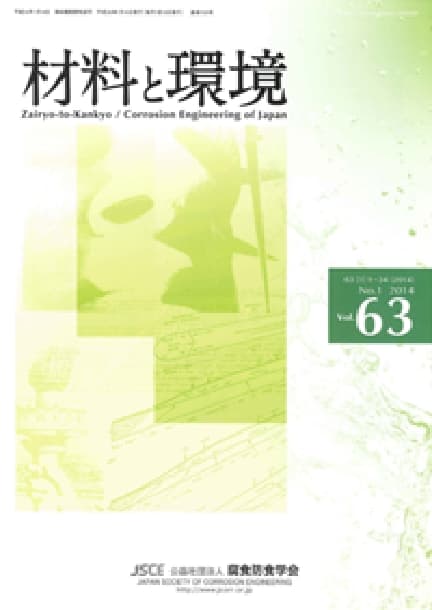- TOP
- Zairyo-to-Kankyo
- Vol. 62 (2013), No. 1
Zairyo-to-Kankyo Vol. 62 (2013), No. 1
Backnumber
-
Vol. 74 (2025)
-
Vol. 73 (2024)
-
Vol. 72 (2023)
-
Vol. 71 (2022)
-
Vol. 70 (2021)
-
Vol. 69 (2020)
-
Vol. 68 (2019)
-
Vol. 67 (2018)
-
Vol. 66 (2017)
-
Vol. 65 (2016)
-
Vol. 64 (2015)
-
Vol. 63 (2014)
-
Vol. 62 (2013)
-
Vol. 61 (2012)
-
Vol. 60 (2011)
-
Vol. 59 (2010)
-
Vol. 58 (2009)
-
Vol. 57 (2008)
-
Vol. 56 (2007)
-
Vol. 55 (2006)
-
Vol. 54 (2005)
-
Vol. 53 (2004)
-
Vol. 52 (2003)
-
Vol. 51 (2002)
-
Vol. 50 (2001)
-
Vol. 49 (2000)
-
Vol. 48 (1999)
-
Vol. 47 (1998)
-
Vol. 46 (1997)
-
Vol. 45 (1996)
-
Vol. 44 (1995)
-
Vol. 43 (1994)
-
Vol. 42 (1993)
-
Vol. 41 (1992)
-
Vol. 40 (1991)
Keyword Ranking
18 Dec. (Last 30 Days)
Zairyo-to-Kankyo Vol. 62 (2013), No. 1
Study of Protective Coating on Steel Wire Strands for Telecommunications in Coastal Areas
Mariko Nakamura
pp. 3-8
DOI:
10.3323/jcorr.62.3Abstract
Communication lines are usually composed of steel and other metallic components and are built outdoors. To determine whether local corrosion is inhibited in coastal areas, which are tough on metals, we conducted a longterm (23 years) exposure test on Miyake Island. The test candidate was steel suspension wire used for suspending communication cables on telephone poles. For preventing corrosion such wires, Zn coating had been used. However, some steel wire strands located in coastal areas still corroded. This is because air born sea salt particles from the ocean are blown by the wind and adhere to the surface of metals. To protect steel wires against atmospheric corrosion, Al coating was applied because of its higher corrosion resistance compared with that of Zn coating. This coating still did not prevent corrosion at specific points in the coastal areas. We compared three types of steel wire strands, Zn coated and Al coated, which are currently used for protecting steel wires, and one Al coated with sacrificial anode tape was efficient in preventing on steel wires had efficacy as protecting corrosion by conducting the exposure test in Miyake Island for 23 years.
Chemical State Analysis of Tin Oxide Films by Voltammetry using Ammonia Buffer as the Supporting Electrolyte
Shigeyoshi Nakayama, Takayasu Sugihara, Takenori Notoya, Toshiyuki Osakai
pp. 16-21
DOI:
10.3323/jcorr.62.16Abstract
A new voltammetric method for determination of the oxides on tin was proposed. In an ammonia buffer solution (0.5 M NH4OH+0.5 M NH4Cl), well-defined reduction peaks for SnO and hydrated SnO2 (denoted as SnO2・nH2O) were observed in a current-potential curve. The peak potentials were fully separated by -0.3 V, since NH4+ ions facilitated the reduction of SnO2・nH2O. On the other hand, in a borate buffer solution, which has been frequently used as the supporting electrolyte for this purpose, and in 1 M KCl containing higher concentration of ions, the peak of SnO2・nH2O was not detected. By using the ammonia buffer solution, we found that the main corrosion products formed on tin in air were SnO and SnO2・nH2O. It was also found that SnO was formed in air at a temperature higher than 100℃, while SnO2・nH2O was formed at a temperature below 100℃ with a higher relative humidity of 90%. The amounts of the respective oxides increased with temperature and relative humidity. In addition, the film thicknesses of tin oxides estimated from the areas of reduction peaks were close agreement with FIB/SEM data.
Article Access Ranking
18 Dec. (Last 30 Days)
-
Delayed Fracture Mechanism of 1700 MPa-Class Quenched and Tempered Bolt under Atmospheric Corrosion Environment
Tetsu-to-Hagané Advance Publication
-
Perspectives on the Promising Pathways to Zero Carbon Emissions in the Steel Industry toward 2050
ISIJ International Vol.65(2025), No.2
-
Effect of B on Surface Oxidation Behavior and Phosphatability of Si-Mn-added Cold-Rolled Steel Sheets
ISIJ International Advance Publication
-
Factors Influencing the Bonding Phase Structure of Iron Ore Sinters
ISIJ International Vol.43(2003), No.9
-
Effect of microstructural heterogeneity on fatigue limit of as-quenched low-carbon low-alloy martensitic steel
ISIJ International Advance Publication
-
Prussian blue as a fully reversible hydrogenochromic material for visualizing hydrogen distribution in Fe sheet
ISIJ International Advance Publication
-
Metallurgical Aspects on Interstitial Free Sheet Steel From Industrial Viewpoints
ISIJ International Vol.34(1994), No.1
-
Microstructures and Reduction Properties of High CaO Concentration Sintered Ore
ISIJ International Advance Publication
-
Influence of Antimony on the Oxidation Characteristics of 65Mn Steel
ISIJ International Advance Publication
-
From plasticity to fracture in pearlitic microstructures: Atomistic study of cementite thickness and deformation localization
ISIJ International Advance Publication
You can use this feature after you logged into the site.
Please click the button below.










